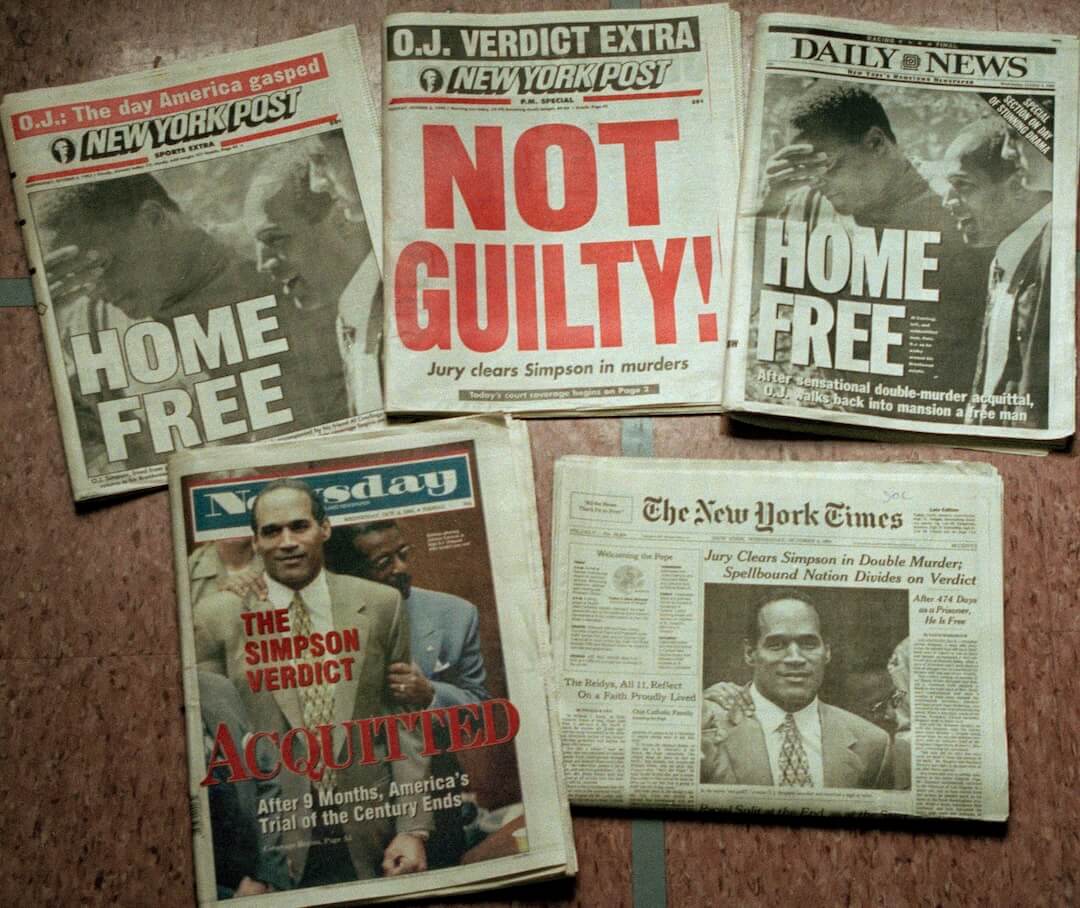O.J. Simpson died this week at 76 after a battle with prostate cancer.
What else belongs in that sentence was a question newsrooms around the country tried to answer Thursday.
How do you adequately capture an all-American football phenomenon and larger-than-life Black celebrity who took a horrifying turn to murder suspect and then defendant in a “trial of the century” that galvanized a nation in front of the television; a 20th-century symbol and an enduring fascination?
The challenge of describing Simpson is a testament to just how complicated a figure he was. For its headline, The New York Times went with “Athlete Whose Trial Riveted the Nation,” while The Washington Post landed on “football great whose trial for murder became a phenomenon.”
The news of Simpson’s death was announced by his family on Thursday, prompting discussions of his life, legacy and what his trial and acquittal in the stabbing deaths of ex-wife Nicole Brown Simpson and waiter Ron Goldman mean close to 30 years later.
The trial, with a beloved celebrity defendant, a backdrop of racial tension only a few years after the 1992 Los Angeles riots, a breaking news car chase and footage from inside the courtroom, made for a natural media sensation. Ethical case studies abounded from trial coverage.
Time magazine’s June 1994 cover, featuring Simpson’s mugshot with a dramatic filter overlay that caught flak for darkening his skin color to make him look more sinister — and guilty — is a classic example in journalism classes of the ethics of photo manipulation.
Judge Lance Ito’s decision to allow cameras in the courtroom, itself a tricky ethical decision at the intersection of due process and the media, made the constant trial footage compelling fodder for viewers (and a standout example for critics of televised trials).
That steady stream of footage also helped Court TV make a name for itself, a kingmaking moment for the young network following its coverage of the Menendez brothers murder trial.
And TMZ, which had the first media reports of Simpson’s death, was created by Harvey Levin, who came to prominence as a lawyer-turned-journalist at Los Angeles’ KCBS-TV while covering the Simpson murder trial.
Trial coverage also gave plenty of other reporters and commentators their big breakout moments: Jeanine Pirro, Greta Van Susteren, Geraldo Rivera, Jeffrey Toobin and more.
It’s hard to overstate how seismic Simpson’s trial and acquittal were. His death immediately led to reflections on that spectacle, the lasting impact on the news media, and the lessons journalists should remember the next time there’s a “trial of the century.” (Toobin, for his part, was doing just that in a recent Q&A with Politico about former president Donald Trump’s upcoming trial).
Here are some of the obituaries:
- The New York Times with “O.J. Simpson, Athlete Whose Trial Riveted the Nation, Dies at 76.”
- The Washington Post with “O.J. Simpson, football great whose trial for murder became a phenomenon, dies at 76.”
- The San Francisco Chronicle, where Simpson was from, with “O.J. Simpson, fallen football hero and S.F. native, dies at 76.”
- ESPN with “O.J. Simpson dies of cancer at age 76, family says.”
- Not an obituary but an interesting piece of coverage: USA Today with “O.J. Simpson just died. Is it too soon to talk about his troubled past?” The piece compares Simpson’s legacy with figures like early rock ‘n’ roll star Jerry Lee Lewis, whose music career was derailed when he married his 13-year-old cousin, and Playboy founder Hugh Hefner, who was accused of rape in a docuseries released after his death.
By Annie Aguiar, audience engagement producer
A cross-generational media fascination
As Tom Jones noted earlier this week in The Poynter Report while writing about the networks’ superior camera equipment during the total solar eclipse, some unifying moments are just owned by broadcast television.
I was born in 1998, years after Simpson was found innocent and the media circus had long packed up its tents. Occasional references permeated pop culture, and that passing knowledge calcified into an after-the-fact fascination in 2016 with “O.J.: Made in America” and “The People vs. O.J. Simpson: American Crime Story.”
Simpson was such an enduring media figure, it doesn’t matter that I wasn’t even alive to sit in front of the television watching the white Bronco: Today, I turned to broadcast news to hear about O.J. Simpson.
I tuned into CBS News’ streaming network live today on X. Apologies to the team at CBS News, which I’m sure is doing great work on a consistent basis, but I don’t know if I’ve ever done that before.
But today, in a way my elder Gen Z, TikTok-addled brain and sad little attention span usually cringes at, I just wanted to hear a steady stream of experts with relevant archival footage. CBS News delivered that to me — and about 7,100 other viewers on X by the time I was done.
By Annie Aguiar, audience engagement producer
Former DCist journalists tease new worker-led outlet
Several former DCist journalists are soliciting names for a “worker-led, community-based, local outlet — one run by the people who actually make the journalism, not a C-suite.”
WAMU, an NPR member station owned by American University, abruptly shut down local news site DCist in February, laying off 15 people. WAMU general manager Erika Pulley-Hayes told Axios at the time that the organization was looking to focus on its audio products. Since the shutdown, a group of former DCist reporters have teased the possibility of starting their own worker-led outlet on social media.
“We’re committed to representing what it really means to live in D.C. Our coverage will serve the whole city: every ward, and each community that lives in and loves the District,” reads a Google Form asking people to help name the new outlet. “Our reporting will be guided by justice and equity, tackling the complex issues facing our city, like housing, safety, and education, from the perspective that all residents deserve these fundamental rights. Of course, we’re also going to be funny, curious, and irreverent at times… honoring the DCist tradition.”
Name options include 51st News, DCish, The DC Star, DC Free Press and WashRag. The group is also seeking suggestions for a tagline for their new outlet.
As layoffs in the industry abound, more and more journalists are starting worker-owned models with their former colleagues. Last year, reporters from Vice Media’s Motherboard launched 404 Media after Vice declared bankruptcy. Meanwhile, several staffers at Kotaku, owned by G/O Media, started their own outlet, Aftermath. The Colorado Sun, Defector and the current iteration of The Appeal have similar origin stories. The trend of journalists regrouping to start new ventures after a media outlet crash has long been a trend in the nonprofit news world, according to Poynter contributor Amaris Castillo.
By Angela Fu, media business reporter
Media tidbits and links for your weekend review
- “Usually, you need about 10 minutes to walk from the Rayburn House Office Building to the House Chamber. But if you’re running from a reporter, it’ll only take you five.” What a lede! It’s The Atlantic’s Elaine Godfrey with “Matt Gaetz is winning. But what’s the prize he’s after?”
- The MAGA movement and Fox News once seemed poised for a breakup. Founder and then-head Rupert Murdoch seemed to be souring on Donald Trump, and Trump was outraged when Fox News called Arizona — and therefore the 2020 election — for Joe Biden. But as Murdoch watched MAGA viewers’ contempt for the network growing, his tune may have changed — and he’s no longer in charge. “Now, four years later,” The Hollywood Reporter’s Lachlan Cartwright writes, “those close to Trump tell The Hollywood Reporter the ex-president is keen to establish more of a relationship with Murdoch’s eldest son and Fox Corp. CEO Lachlan, 52.”
- Speaking of Fox News, here’s The New York Times’ David Enrich with “How a Case Against Fox News Tore Apart a Media-Fighting Law Firm.”
- “The premium for people who can tell you things you do not know will only grow in importance, and no machine will do that,” says Jim VandeHei, CEO of Axios. The New York Times’ Katie Robertson has more on how Axios is preparing for artificial intelligence.
- Smart coverage from The Washington Post’s Philip Bump on Arizona’s abortion ban, which is derived from an 1864 law. Bump writes, “Here are some other laws Arizona had on the books in 1864.”
- The fallout at NPR continues following the publication of a critical column from Uri Berliner, a senior business editor who has worked at NPR for 25 years, in The Free Press. The New York Times’ Benjamin Mullin and Katie Robertson write “NPR in Turmoil After It Is Accused of Liberal Bias.”
- Another day that ends in “Y,” more outrage about journalists doing the most basic components of their jobs.
- Major League Baseball will likely move its Sunday morning games away from Peacock to another network, Andrew Marchand reports for The Athletic.
- Your internet service provider will soon unveil a “nutrition label” that will note speeds, fees and data caps. Engadget’s Mariella Moon shares what to expect.
- Axios’ Hope King with “James Cameron on tackling the next ‘Terminator.’”
- For Vanity Fair, it’s media reporter Brian Stelter with “The Caitlin Clark Effect.”
- This is fun … and unexpected. The Associated Press’ Steve Reed with “No inflation here: Affordable Masters’ menu still includes $1.50 pimento cheese sandwiches.”
More resources for journalists
- Cover trans issues with authority and accuracy in our Beat Academy webinars. Enroll today.
- Delve more deeply into your editing skills with Poynter ACES Intermediate Certificate in Editing.
- TV producers, consider our Poynter Producer Project. Apply by April 14.
- Editorial Integrity and Leadership Initiative is a fellowship for public media journalists. Apply by April 22.
Have feedback or a tip? Email Poynter senior media writer Tom Jones at tjones@poynter.org.
The Poynter Report is our daily media newsletter. To have it delivered to your inbox Monday-Friday, sign up here.









